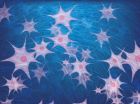(Press-News.org) UPTON, NY -- Sometimes a cell has to die-when it's done with its job or inflicted with injury that could otherwise harm an organism. Conversely, cells that refuse to die when expected can lead to cancer. So scientists interested in fighting cancer have been keenly interested in learning the details of "programmed cell death." They want to understand what happens when this process goes awry and identify new targets for anticancer drugs.
The details of one such target have just been identified by a group of scientists from the U.S. Department of Energy's Brookhaven National Laboratory, Columbia University, New York University, Baylor College of Medicine, Technical University of Munich, and the New York Structural Biology Center. The group, known as the New York Consortium on Membrane Protein Structure (NYCOMPS), used x-rays at Brookhaven Lab's National Synchrotron Light Source (NSLS) to decipher the atomic level structure of a protein that regulates the level of calcium in cells. The work is described as a research article published in Science, June 6, 2014.
"The accumulation of calcium is a key signaling agent that can trigger programmed cell death, or apoptosis," explained Wayne Hendrickson of Columbia and Brookhaven, and the director of NYCOMPS as well as a senior author on the paper. "Our study reveals how this protein, embedded in a cellular membrane structure called the endoplasmic reticulum, serves as a molecular safety valve for keeping calcium levels steady. Designing drugs that inhibit this protein would promote cell death, which could be a promising strategy for fighting cancers in which such proteins are overexpressed."
3-D Model for Rational Drug Design
The protein that the scientists studied is a prokaryotic homolog of human "Transmembrane Bax Inhibitor Motif" (TMBIM) proteins, which come in six varieties. TMBIM6 is overexpressed in various cancers-including prostate, breast, glioma, uterine, ovarian, and lung.
"Our work using the prokaryotic version of this protein has enabled us to construct a three-dimensional model that can be used as a basis for the rational design of possible inhibitor molecules," said Qun Liu, a scientist at NSLS and NYCOMPS and the lead author on the paper.
The atomic-level structures were determined using x-ray crystallography at NSLS beamlines X4A and X4C. Interactions of x-rays with the 3-D lattices of the protein molecules produce diffraction patterns from which the 3-D molecular images were derived. The images reveal a novel structure consisting of a centralized helix wrapped by two novel triple-helix sandwiches that traverse the membrane. The central portion can take on an open or closed conformation dependent on the acidity level, or pH. At physiological pH, open and closed conformations exist in equilibrium, maintaining a steady of state of calcium in the cell by allowing gradual leakage of calcium across the membrane through a transient transmembrane pore.
"This leak is intrinsic to all kinds of cells and is cytoprotective for life, similar to a pressure safety value used in a standard steam boiler for safety assurance," said Liu.
The studies reveal in detail how the TMBIM protein senses and responds to changes in acidity to precisely regulate the mechanism.
"The next step will be to solve crystal structures of the human TMBIM proteins to refine the design of possible inhibitor drugs," said Liu.
That work will take place at a new light source nearing completion at Brookhaven known as NSLS-II. That facility, set to start early experiments later this year, will be 10,000 times brighter than NSLS, making it particularly suitable for studies of membrane proteins, which are difficult to crystallize.
The New York Structural Biology Center is working in partnership with Photon Sciences at Brookhaven to build a microdiffraction beamline, called NYX, for advanced studies of biological molecules at NSLS-II.
INFORMATION:
This research was supported in part by the National Institutes of Health (NIH) grant GM095315 and GM107462. The NSLS at Brookhaven Lab is a DOE Office of Science user facility, with beamlines X4A and X4C supported by the New York Structural Biology Center.
Scientific paper: http://www.sciencemag.org/content/344/6188/1131.abstract
DOE's Office of Science is the single largest supporter of basic research in the physical sciences in the United States, and is working to address some of the most pressing challenges of our time. For more information, please visit science.energy.gov.
One of ten national laboratories overseen and primarily funded by the Office of Science of the U.S. Department of Energy (DOE), Brookhaven National Laboratory conducts research in the physical, biomedical, and environmental sciences, as well as in energy technologies and national security. Brookhaven Lab also builds and operates major scientific facilities available to university, industry and government researchers. Brookhaven is operated and managed for DOE's Office of Science by Brookhaven Science Associates, a limited-liability company founded by the Research Foundation for the State University of New York on behalf of Stony Brook University, the largest academic user of Laboratory facilities, and Battelle, a nonprofit applied science and technology organization.
Scientists reveal details of calcium 'safety-valve' in cells
Structure of membrane protein that plays a role in signaling cell death could be new target for anticancer drugs
2014-06-06
ELSE PRESS RELEASES FROM THIS DATE:
Brain traffic jams that can disappear in 30 seconds
2014-06-06
BUFFALO, N.Y. – Motorists in Los Angeles, San Francisco and other gridlocked cities could learn something from the fruit fly.
Scientists have found that cellular blockages, the molecular equivalent to traffic jams, in nerve cells of the insect's brain can form and dissolve in 30 seconds or less.
The findings, presented in the journal PLOS ONE, could provide scientists much-needed clues to better identify and treat neurodegenerative diseases such as Alzheimer's and Huntington's.
"Our research suggests that fixed, permanent blocks may impede the transport of important ...
LSU biologist John Caprio, Japanese colleagues identify unique way catfish locate prey
2014-06-06
BATON ROUGE – Animals incorporate a number of unique methods for detecting prey, but for the Japanese sea catfish, Plotosus japonicus, it is especially tricky given the dark murky waters where it resides.
John Caprio, George C. Kent Professor of Biological Sciences at LSU, and colleagues from Kagoshima University in Japan have identified that these fish are equipped with sensors that can locate prey by detecting slight changes in the water's pH level.
A paper, "Marine teleost locates live prey through pH sensing," detailing the work of Caprio and his research partners, ...
Better tissue healing with disappearing hydrogels
2014-06-06
When stem cells are used to regenerate bone tissue, many wind up migrating away from the repair site, which disrupts the healing process. But a technique employed by a University of Rochester research team keeps the stem cells in place, resulting in faster and better tissue regeneration. The key, as explained in a paper published in Acta Biomaterialia, is encasing the stem cells in polymers that attract water and disappear when their work is done.
The technique is similar to what has already been used to repair other types of tissue, including cartilage, but had never ...
Lower asthma risk is associated with microbes in infants' homes
2014-06-06
Infants exposed to a diverse range of bacterial species in house dust during the first year of life appear to be less likely to develop asthma in early childhood, according to a new study published online on June 6, 2014, in the Journal of Allergy and Clinical Immunology.
Children who were neither allergic nor prone to wheezing as three-year-olds were the most likely to have been exposed to high levels of bacteria, and paradoxically, to high levels of common allergens.
In fact, some of the protective bacteria are abundant in cockroaches and mice, the source of these ...
NASA and NOAA satellites eyeing Mexico's tropical soaker for development
2014-06-06
NASA and NOAA satellites are gathering visible, infrared, microwave and radar data on a persistent tropical low pressure area in the southwestern Bay of Campeche. System 90L now has a 50 percent chance for development, according to the National Hurricane Center and continues to drop large amounts of rainfall over southeastern Mexico.
The Atmospheric Infrared Sounder (AIRS) instrument aboard NASA's Aqua satellite gathered infrared data on the developing low on June 5 at 18:59 UTC (2:59 p.m. EDT).
Basically, AIRS looks at the infrared region of the spectrum. In a spectrum, ...
Study shows health policy researchers lack confidence in social media for communication
2014-06-06
Philadelphia – Though Twitter boats 645 million users across the world, only 14 percent of health policy researchers reported using Twitter – and approximately 20 percent used blogs and Facebook – to communicate their research findings over the past year, according to a new study from the Perelman School of Medicine at the University of Pennsylvania. In contrast, sixty-five percent used traditional media channels, such as press releases or media interviews. While participants believed that social media can be an effective way to communicate research findings, many lacked ...
Evolution of a bimetallic nanocatalyst
2014-06-06
Atomic-scale snapshots of a bimetallic nanoparticle catalyst in action have provided insights that could help improve the industrial process by which fuels and chemicals are synthesized from natural gas, coal or plant biomass. A multi-national lab collaboration led by researchers with the U.S. Department of Energy (DOE)'s Lawrence Berkeley National Laboratory (Berkeley Lab) has taken the most detailed look ever at the evolution of platinum/cobalt bimetallic nanoparticles during reactions in oxygen and hydrogen gases.
"Using in situ aberration-corrected transmission electron ...
Tougher penalties credited for fewer casualties among young male drivers
2014-06-06
VIDEO:
A new Western University study led by Dr. Evelyn Vingilis has found a significant decline in speeding-related fatalities and injuries among young men in Ontario since the province's tough extreme...
Click here for more information.
A new study out of Western University (London, Canada) has found a significant decline in speeding-related fatalities and injuries among young men in Ontario since the province's tough extreme speeding and aggressive driving laws were introduced ...
Endoscope with an oxygen sensor detects pancreatic cancer
2014-06-06
JACKSONVILLE, Fla. — June 6, 3014 — An optical blood oxygen sensor attached to an endoscope is able to identify pancreatic cancer in patients via a simple lendoscopic procedure, according to researchers at Mayo Clinic in Florida.
The study, published in GIE: Gastrointestinal Endoscopy, shows that the device, which acts like the well-known clothespin-type finger clip used to measure blood oxygen in patients, has a sensitivity of 92 percent and a specificity of 86 percent.
MULTIMEDIA ALERT: Video and audio are available for download on the Mayo Clinic News Network.
That ...
Magnetic moment of the proton measured with unprecedented precision
2014-06-06
One of the biggest riddles in physics is the apparent imbalance between matter and antimatter in our universe. To date, there is no explanation as to why matter and antimatter failed to completely annihilate one another immediately after the big bang and how the surplus matter was created that went on to form the universe as we know it. Experiments conducted at Johannes Gutenberg University Mainz (JGU) have contributed towards a resolution of this problem. For the first time a direct and high-precision measurement of the magnetic moment of the proton has been conducted ...
LAST 30 PRESS RELEASES:
Bluey’s dad offered professorial chair in archaeology at Griffith University
Beyond small data limitations: Transfer learning-enabled framework for predicting mechanical properties of aluminum matrix composites
Unveiling non-thermal catalytic origin of direct current-promoted catalysis for energy-efficient transformation of greenhouse gases to valuable chemicals
Chronic breathlessness emerging as a hidden strain on hospitals
Paleontologists find first fossil bee nests made inside fossil bones
These fossils were the perfect home for ancient baby bees
Not everyone reads the room the same. A new study examines why.
New research identifies linked energy, immune and vascular changes in ME/CFS
Concurrent frailty + depression likely boost dementia risk in older people
Living in substandard housing linked to kids’ missed schooling and poor grades
Little awareness of medical + psychological complexities of steroid cream withdrawal
Eight in 10 trusts caring for emergency department patients in corridors, finds BMJ investigation
NASA’s Webb telescope finds bizarre atmosphere on a lemon-shaped exoplanet
The gut bacteria that put the brakes on weight gain in mice
Exploring how patients feel about AI transcription
Category ‘6’ tropical cyclone hot spots are growing
Video: Drivers struggle to multitask when using dashboard touch screens, study finds
SLU research shows surge in alcohol-related liver disease driving ‘deaths of despair’
Rising heat reshapes how microbes break down microplastics, new review finds
Roots reveal a hidden carbon pathway in maize plants
Membrane magic: FAMU-FSU researchers repurpose fuel cells membranes for new applications
UN Member States pledge to increase access to diagnosis and inhaled medicines for the 480 million people living with COPD
Combination therapy shows potential to treat pediatric brain cancer ATRT
Study links seabird nesting to shark turf wars in Hawai‘i
Legal sports betting linked to sharp increases in violent crime, study finds
Breakthrough AI from NYUAD speeds up discovery of life-supporting microbes
New Eva Mayr-Stihl Foundation funding initiative boosts research at University of Freiburg on adaptation of forests to global change
The perfect plastic? Plant-based, fully saltwater degradable, zero microplastics
Bias in data may be blocking AI’s potential to combat antibiotic resistance
Article-level metrics would provide more recognition to most researchers than journal-level metrics
[Press-News.org] Scientists reveal details of calcium 'safety-valve' in cellsStructure of membrane protein that plays a role in signaling cell death could be new target for anticancer drugs





